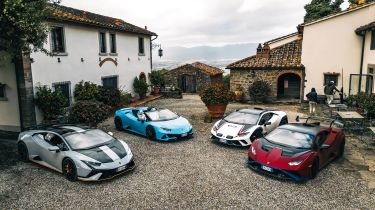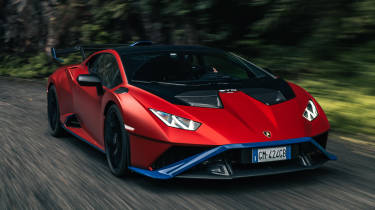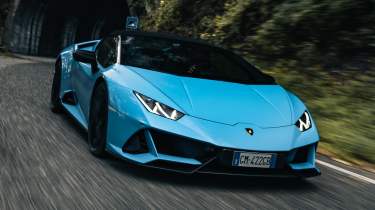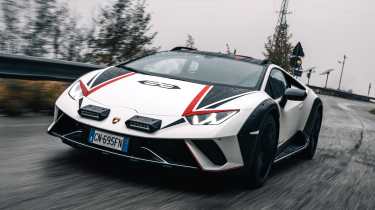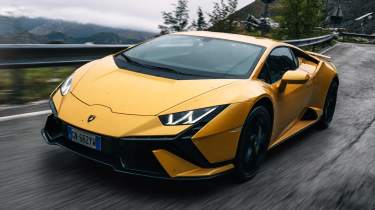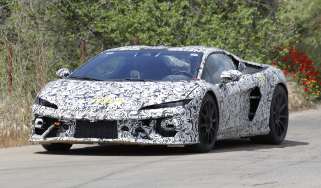Lamborghini V10: farewell to the engine that made the Huracan
We say a fond farewell to Lamborghini’s glorious V10 with an Italian road trip in the final four Huracans to use the powerplant
Street signs flash past with place names that even the most jaded car fan can’t help but get giddy over. Maranello, Modena, and now Sant’ Agata, and it’s this last iconic location that we’re heading to on our pilgrimage to the home of Lamborghini.
In contrast to the more strait-laced Ferrari, steeped in its motorsport heritage, Lamborghini has typically taken a more rebellious approach.
It’s a mantra still identifiable in everything that rolls out of the factory doors, one that in the modern era has been defined by the engine we’re here to say goodbye to: Lamborghini’s naturally aspirated V10. Since its inception, this brash, loudly spoken engine has been a critical factor in Lamborghini’s success by powering its baby supercars. First found in the Gallardo, and now the Huracan, the V10 embodies the notion of rebellion due to, if nothing else, its sheer volume on start-up.
But before we make tracks on our indulgent road trip, it’s high time we put a misconception to rest. The Lamborghini V10 is not an Audi engine with some Italian magic sprinkled over the top; rather it’s Lamborghini’s engine that was engineered from scratch for a not insignificant £110million, after Audi’s buy-out of the storied Italian marque in the early noughties. That the engine also happens to be used in the Audi R8 supercar and is built in Audi’s engine plant in Hungary might make it sound otherwise, but its origins are purely Italian.
Lamborghini Huracan STO
Sitting in front of the Sant’ Agata factory are the final four roadgoing models to feature the enigmatic V10 engine. Running through the bewinged STO, glamorous Huracan Evo Spyder, fantastical Sterrato and the Tecnica, each adds a distinct flavour to the range. Over the next two days, we’ll be parading all four across northern Italy from our base just outside Bologna to Forte dei Marmi on the west coast and back again. A carnival celebration for the V10.
We start our trip in the STO, heading from the factory to our first overnight stop just east of Bologna. Even just traversing dull commuter roads on the Po Plain that bisects Emiglia Romagna and the Tuscan hills, I can think of few cars with more theatre. In every moment the V10 has such a specific personality, made yet more dramatic by the unusual way its exhaust system’s internal valves work. Technically they activate when you open the throttle to a certain point, but if you lift off and go back on (as you do in normal day-to-day driving) they find a voice of their own, barking gobfuls of noise into the atmosphere almost of their own accord. It sounds annoying; it isn’t.
This is a quirk which will run across all Huracan models in our playlist, but the STO differs in one key aspect. This track-focused model is the most hardcore roadgoing Huracan, and it resolutely sticks to the brief. Inside, the uncompromising carbon bucket seats reside with bare carbon door cards, composite footwells and a complete absence of storage. This helps the noise from the engine resonate in the cabin in what feels like every direction.
There are other differences, too. In contrast to every other Huracan, the STO’s nose has been redesigned to accommodate a single forward-opening carbon-fibre clamshell in place of a traditional bonnet and front wings. This reduces weight but also essentially deletes the only storage space. Do I care? My luggage is in the back of a support Urus a few miles up the road, so not a bit...
This level of practical compromise would be pointless if it didn’t deliver some tangible benefit, but when it comes to the STO you feel it every time you turn the steering wheel. This is a light car at 1,339kg, but when combined with rear-wheel steering and a relatively fast rack, it exaggerates its agility. But it’s not just the speed in which the STO turns, but the malleable way the steering allows you to command the car with complete confidence. It’s this element of the driving experience that highlights just how far the Huracan has evolved in its later life, given that the original was noted for its poor steering feel.
Lamborghini Huracan Evo Spyder
The next morning we’re faced with the polar opposite of the STO, lifting its lid and adding around 200kg to create the Spyder. No two contemporary Huracans are more diverse, and not just on account of the body shape, but also their feel. The 5.2-litre V10 and its 631bhp power figure is shared with the STO, but the Spyder is softer in its delivery, with less of a reliance on revs to deliver thrust. It’s also packing two extra driven wheels, and while it does feature rear-wheel steering, it’s paired with a dynamic rack that varies the ratio depending on your speed.
There’s a definite sense of extra mass, plus a level of compromise in the chassis’ stiffness and steering feel. And yet despite these drawbacks, the Spyder instead appeals to a sense of glamour that Lamborghini has also long been known for. In this example’s striking baby blue, offset with a white and blue leather interior, it reeks of the stuff.
Yet the Spyder’s biggest talent is extracting an even more three-dimensional rendition of the music from those tailpipes. When slipping through the dark tunnels that burrow their way through the Tuscan hills, it’s an almost violent experience, one that any car fan would take to the grave; a celebration of explosive proportions and matching blue flames to go with it.
Lamborghini Huracan Sterrato
Later that morning, it’s time to drive the Sterrato – a very unusual breed of off-roading supercar. Having spoken to some of the Lamborghini engineering team, we find this car had been on the cards for a long time, but untested customer demand made it a risk. Still, right at the end of the Huracan’s life, space was made for this most unusual of derivatives, and here it sits with its plastic wheelarch extensions, spotlights and (functional) roof rails, incongruently applied to a piece of classic Italian wedge.
The cabin is a bizarre combination of racing car-like appendages, such as the carbon bucket seats from the STO and, in our particular example, a half-roll cage, but you sit higher off the ground and straight away feel the extra travel and compliance in its suspension. Over the tough and broken road surfaces leading up to barren off-season skiing villages, the Sterrato adds a new and unique layer to the Huracán driving experience. It feels less vulnerable and more robust, as if you can aim for the worst sections of road, rather than avoid them through fear of expensive impacts of carbon fibre on tarmac.
With a comparatively subdued 614bhp and a general lack of weight-saving measures, it doesn’t feel quite as rapid as the others here. Instead you attack the road at a more measured pace, let the car lean into its suspension travel and turn what can sometimes be a frantic experience on narrow Italian back roads into a more measured one. This isn’t a marker against it, and in fact the Sterrato is terrific fun with its limits accessible at lower speeds, so lessening the anxiety associated with driving a very expensive car on foreign roads.
The only real weakness is the rubber fitted, because while the bespoke off-road Bridgestone tyres and their knobbly sidewalls look the part, they compromise the steering feel, losing that delicious sense of precision and feedback that is at the core of the Huracan experience.
Lamborghini Huracan Tecnica
The sun is now setting on the gentler Tuscan hills leading us back to the Lamborghini factory. Our final pause finds all the cars lined up on a ridge in a stunning golden haze, so typical of this beautiful part of the world. The only car left to drive is the Tecnica, and after some experience of it in the UK, I know that it might just be the sweetest in my particular chocolate box. From here it’s a solid blast back down the hilly terrain towards Bologna.
Keen to get ahead on the route back to the factory, one of our supporting Urus Performantes – with an ace Lamborghini Super Trofeo racing driver at the wheel – bolts off. It’s just too much of a temptation not to leave the pack and follow, so I take it upon myself to join and let him set the pace.
The Tecnica is a revelation. Each of these Huracans have been variations on a theme, but on this specific strip of tarmac we’ve hit the sweet spot. The Tecnica’s powertrain is just as excitable and expressive as the STO’s, but in the place of the sometimes unrelenting ride quality is a new level
of suppleness that reveals a stunning balance and sophistication to the Huracan’s chassis. The steering is magnificent: less granular, but more resilient to tarmac that’s often off-camber and rippled, sometimes broken with cracks typical of roads frozen and thawed over the seasons.
The engine feels as if it has reached nirvana, its calibration and feedback from the throttle almost telepathically linked to your right foot. With the windows down, I can hear the V10 bounce back across the hillsides. Now the shifts of its twin-clutch transmission are set at maximum attack, finding a perfect balance between speed, engagement and control. With only two driven wheels, there’s a level of adjustability to explore too, although the reality of a big mid-mounted engine within a relatively short wheelbase must never be taken for granted.
This is where Lamborghini’s V10 supercar peaks, an expression of how this rambunctious Italian company has created a supercar with real depth, talent and expertise. We’re now, quite literally, driving this ultimate Huracan into the sunset, and can’t help but feel like we’ve been on this journey together. The best supercars aren’t about the way they make you feel at 10mph on the King’s Road, or how they look in a pristine garage, but at this moment. The gauntlet has been thrown down for the Huracan’s hybrid-assisted successor due next year, but living up to this car and its magnificent V10 seems nearly impossible.
Click here for our list of the best supercars...
Find a car with the experts

